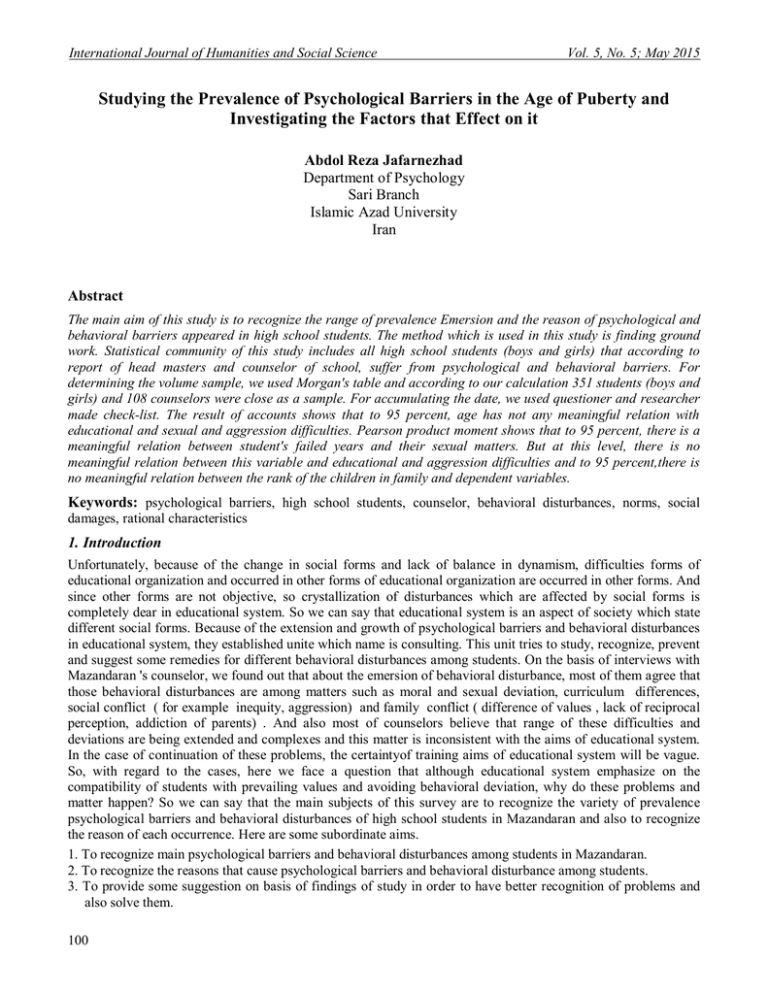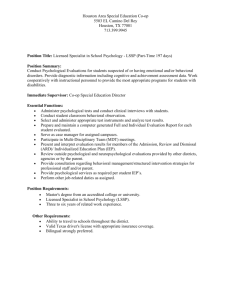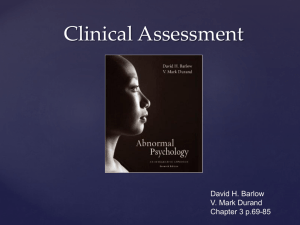Studying the Prevalence of Psychological Barriers in the Age of... Investigating the Factors that Effect on it
advertisement

International Journal of Humanities and Social Science Vol. 5, No. 5; May 2015 Studying the Prevalence of Psychological Barriers in the Age of Puberty and Investigating the Factors that Effect on it Abdol Reza Jafarnezhad Department of Psychology Sari Branch Islamic Azad University Iran Abstract The main aim of this study is to recognize the range of prevalence Emersion and the reason of psychological and behavioral barriers appeared in high school students. The method which is used in this study is finding ground work. Statistical community of this study includes all high school students (boys and girls) that according to report of head masters and counselor of school, suffer from psychological and behavioral barriers. For determining the volume sample, we used Morgan's table and according to our calculation 351 students (boys and girls) and 108 counselors were close as a sample. For accumulating the date, we used questioner and researcher made check-list. The result of accounts shows that to 95 percent, age has not any meaningful relation with educational and sexual and aggression difficulties. Pearson product moment shows that to 95 percent, there is a meaningful relation between student's failed years and their sexual matters. But at this level, there is no meaningful relation between this variable and educational and aggression difficulties and to 95 percent,there is no meaningful relation between the rank of the children in family and dependent variables. Keywords: psychological barriers, high school students, counselor, behavioral disturbances, norms, social damages, rational characteristics 1. Introduction Unfortunately, because of the change in social forms and lack of balance in dynamism, difficulties forms of educational organization and occurred in other forms of educational organization are occurred in other forms. And since other forms are not objective, so crystallization of disturbances which are affected by social forms is completely dear in educational system. So we can say that educational system is an aspect of society which state different social forms. Because of the extension and growth of psychological barriers and behavioral disturbances in educational system, they established unite which name is consulting. This unit tries to study, recognize, prevent and suggest some remedies for different behavioral disturbances among students. On the basis of interviews with Mazandaran 's counselor, we found out that about the emersion of behavioral disturbance, most of them agree that those behavioral disturbances are among matters such as moral and sexual deviation, curriculum differences, social conflict ( for example inequity, aggression) and family conflict ( difference of values , lack of reciprocal perception, addiction of parents) . And also most of counselors believe that range of these difficulties and deviations are being extended and complexes and this matter is inconsistent with the aims of educational system. In the case of continuation of these problems, the certaintyof training aims of educational system will be vague. So, with regard to the cases, here we face a question that although educational system emphasize on the compatibility of students with prevailing values and avoiding behavioral deviation, why do these problems and matter happen? So we can say that the main subjects of this survey are to recognize the variety of prevalence psychological barriers and behavioral disturbances of high school students in Mazandaran and also to recognize the reason of each occurrence. Here are some subordinate aims. 1. To recognize main psychological barriers and behavioral disturbances among students in Mazandaran. 2. To recognize the reasons that cause psychological barriers and behavioral disturbance among students. 3. To provide some suggestion on basis of findings of study in order to have better recognition of problems and also solve them. 100 ISSN 2220-8488 (Print), 2221-0989 (Online) ©Center for Promoting Ideas, USA www.ijhssnet.com Finally, with using these findings, this study tries to provide scientific solution to remove this problem. One of the main reasons of this study is to recognize counselors and student's point of view about some problems and norms (such as curriculum difficulties, student's sexual and behavioral matters and aggression and by focusing on these groups opinions, we can solve this problems with regard to those study and also experience of writer, fore said problems are main existing problems in schools and students are in expose to those problems. So by performing this study, we can cause executive managers and planners to be aware of such matters .by using these scientific views and findings of study, they provide essential basis for decreasing social penalty, deviations and crimes. Kakavand, (1997) was investigating and comparing the effect of absence of parents on behavioral disturbance of children who are in nursery and children who lost their father and are under the control of EmamKhomeiny's Committee and normal children. The findings of this study show that when we compare children who lost their father or mother with normal children, we can see that first group suffer from more behavioral disturbances. Another study in which they investigate and compare the behavioral disturbance of children with special acquisition incompetence with normal children, shows that children who suffer from special acquisition incompetence, have more psychological barrier and behavioral disturbance in compare with normal students (Rafeezade, 2000). In another study Shafi, and Naseri (2001), started to investigate and compare some behavioral disturbances (such as aggression, over activeness, agitation and depression, social incompatibilities, antisocial behavioral, disorder because of lack of attention) in normal children and who don't have father. The results showed that children who don't have father suffer from more behavioral disturbance and psychological barriers than normal children (1978) in an investigation about impatient children, Lonny and others concluded that children who are quarrel some in childhood, will be quarrel some teenagers, too. And the range of activity is a weak factor in relation to school training success. Scot. (1948) in a study, Peterson concluded that psychological barriers and behavioral disturbances, sense of duty, sense of ruinous, impudence, negativism, absent –mindedness, sense of quarrelsome, sense of attention, ill-humor, impatience, to be stimulated, inattention. A lot of researchers such as comings, Emery, Grych, Frisham believe that dissatisfaction or matrimony quarrel in kids and teenagers are in correlation with emersion of psychological barriers and behavioral disturbances. (They rely on existing disturbance in parent-children relation) Barjali, (2001). According to these studies we can say that the existence of disorder in parents duty (especially compatibilities that will be caused of it) make children's transition process problematic. The results of researches show that the existence of unsolved quarrel between parents cause some psychological barriers and behavioral disturbance in children (Barjali , 2001). These researches show that the existence of unsolved quarrel between parents will cause negative feeling and weak compatibility response in children and also the result of study show that parents who use hostilely methods to solve their quarrel, have children with antisocial behavior. In a research, 2250, graduated high school students answered to a questionnaire. The questionnaires represent two things. First the range of psychological barriers and different behavioral disturbances and scrupulous behavioral and second, teenagers perception of their parent's method of children-training. Result of this study shows that there is a meaningful compatibility between children-training methods and older teenagers' behavioral compatibility. According to Barjali (2001) mentioning and investigating conducted study in country or abroad, it is necessary to state the existing psychological barriers and behavioral disturbances in Mazandaran in 2009-2010. The data in table shows the range of psychological barriers and disturbances in Mazandaran. -How is prevalence of female student's problems? (According to the kind and range of problems) 2. Research Method The prevailing method in this research is measurable and beside this method, we used documentary method, too. With regard to prevailing method in this research, the main tools which were used to collect the information of interview and questionary are researcher made tools and based on subjects, we used the documents. We should mention that for recognizing the range of fluency of questions, Kakavand, (1997). coefficient was used them and according to our calculation, it equals 64 and according to statistics and scientific research method, this rigid is an acceptable coefficient. Statistic society of this research includes all high school students (Girls and boys) who suffer from psychological barriers and behavioral disturbances and also all the counselors who work in Mazandaran's schools. 101 International Journal of Humanities and Social Science Vol. 5, No. 5; May 2015 Statistic society includes 37982 people and with regard to Kristian Morgan table they determined 351 references. We used Kristian Morgan table to determine the volume of sample and according to the conducted calculation, 351 students ( boys and girls ) and 180 counselors were chose as a sample and tools such as interview and questionnaires were used in this research. We used randomization to choose the samples but because of respondent right of being anonymous and privacy, the central part of counselor of educational organization tried to gather information. So the correctness of information is in charge of central part of counselor. With regard to the kind of measurable variety, different techniques of descriptive and inference statistics were used and it should be mention that all of the process were conducted with SPSS software. 3. Analysis of Results In descriptive and inference statistics (such as T-test, correlation coefficient, unilateral or multi variables variance analysis and some other statistic tests) we used SPSS software. 1- Does the age of students have any relation with the prevalence of problems? Investigating the relation of dependent variables with the age of students and counselors. Table 1: Investigating the Relation of the Age with Dependent Variables by Using Correlation Coefficient Technique Dependent variables Curriculum problems Students Counselors Technique name amount Pearson 39% Pearson Pearson 46% 0/009% Level of significance 49% 43% 88% Technique name Amount Level significance Pearson 11% 33% Pearson Pearson 10% 12% 34% 29% The result of calculation (Table1) show that in level of 95 percent, there is no significance relation between age and dependent variables. 2- Does the number of students failed years have any relation with prevalence of their problems? Investigating the relation of the number of student's failed years with dependent variables. Since the independent variable is periodical, we used Pearson product moment to recognize the relation of this variable with dependent variable. Table 2: investigating the Relation of Number of Student's Failed Years with Dependent Variables Dependent variables Technique name amount Level of significance Curriculum problems Sexual problems Pearson Pearson Pearson 96% 122% 0/013% 0/093% 0/035% 83% The result of Pearson product -moment calculation show(Table 2) that in the level of 95 percent , there is a significant relation between student's failed years and sexual problems but in this level there is no significance relation between this variable and other dependent variable. 3 – Does the age of student's father have any relation with the prevalence of problems? Investigating the relation of the age of father with dependent variables we used Pearson product-moment technique to recognize and investigate this variable. 102 ISSN 2220-8488 (Print), 2221-0989 (Online) ©Center for Promoting Ideas, USA www.ijhssnet.com Table 3: Investigating the Relation of Father's age with Dependent Variable Dependent variables Curriculum problems Sexual problems Technique name Pearson Pearson Pearson amount 92%0/083% 0/003% Level of significance 0/09% 0/136% 274% The result of calculation (Table3) show that in level of 95 percent, there is no significance relation between the age of the students and dependent variables. 4. Does the age of students' mother have any relation with prevalence of psychological barriers? Investigating the relation of age of mother with dependent variable. We used Pearson product –moment technique to recognize and investigate the relation of education level of father with dependent variables. Table 4: Investigating the Relation of Fathers' Education Level with Dependent Variable Dependent variables Technique name amount Level of significance Curriculum problems Sexual problems Pearson Pearson Pearson 0/037% 0/038% 0/027% 0/505% 0/501% 0/631% The result of Pearson product-moment calculation (Table4) show that in level of 95 percent, there is no significance relation between education level of father and dependent variable. 5- Does the education level of students' mother have any relation with the prevalence of psychological barriers? Since the variables are periodical, we use Pearson product-moment technique to recognize and investigate the relation of education level of mother with dependent variable. The results are in table 7. Table5: Investigating the Relation of Education Level of Mother with Dependent Variable Dependent variables Technique name amount Level of significance Curriculum problems Sexual problems Pearson Pearson Pearson 0/064%0/001% 0/050% 0/244% 0/993% 358% The results of correlation coefficient calculation (Table5) show that in the level of 95percent, there is no significance relation between the education level of mother and dependent variable. 6- Does the age-rank of the student in the family have any relation with the prevalence of their problem? Table 6: Investigating the Relation of Age-Rank of the Student in Family with Dependent Variable Dependent variables Curriculum problems Sexual problems Technique name Pearson Pearson Pearson amount 0/0824%0/85% 0/105% Level of significance 0/143% 0/132% 0/070% The result of Pearson product-moment calculation(Table6) show that in the level of 95 percent, there is no significance relation between the age-rank of student in family and dependent variable. 4. Discussion and Conclusion The investigating of relation of dependent variable with the age of students and counselor shows that in level of 95 percent, there is no significant relation between the age-distance and dependent variables. Investigating the relation of the number students' failed years with dependent variable s (according to the result of Pearson productmoment calculation) shows that in level of 95 percent, there is significant relation between the failed years of students and sexual problems. But in this level, there is no significance relation between this variable and other dependent variables. Investigating the relation of the age of students' father with dependent variable shows that in level of 95 percent, there is no significant relation between the age of father and dependent variables. 103 International Journal of Humanities and Social Science Vol. 5, No. 5; May 2015 Investigating the relation of the age of students' mother with dependent variable shows that in the level of 95 percent, there is no significant relation between the age of mother and dependent variables. Investigating the relation of the education level of father with dependent variables (according to Pearson product-moment calculation) shows that in level of 95 percent , there is no significant relation between the education level of father and dependent variables. Investigating the education level of students' mother with dependent variable ( according to Pearson product-moment results) shows that in the level of 95 percent , there is no significant relation between the level of mother and dependentvariables, investigating the relation of students' age –rank in family with dependent variable ( according to Pearson product-moment results) in the level of 95 percent shows that there is no significant relation between the students' age-rank in family and dependent variable. References Barjali , A (2001) change in teenagers characteristics , Tehran : varidanesh Kakavand, A.R (1997). Investigating and comparing the effect of lack of parents on the range of psychological barriers and behavioral disturbances of children. M.A thesis, psychology and science training college, AlameTabatabaie University. Rafeezade, M.R (2000) Investigating and comparing psychological barriers and behavioral disturbances of students'.M.A thesis, psychology and science training college, AlameTabatabai University. ManeshiTosi (1993), Mashhad:AstanghodsRazavi Safaie, E. (1998). Investigating and comparing some psychological barriers and behavioral disturbances in children who don't have father and normal children, M.A thesis psychology and science training college,AlameTabatabaie University. Seif – A (1998),change in behavior and psychology : Theories and methods , Tehran Scot.M (1948) behavioral – cognitive approach in relation to problems and psychotraphy, Tehran: The central university Nashr ShafiAbadi, A. and Naseri, Gh . (2001), consulting and psychotraphy theory, Thehran: university Nashr 104





